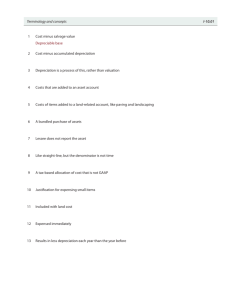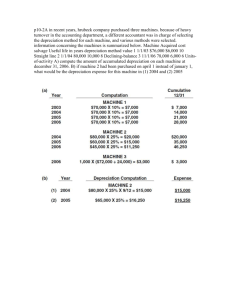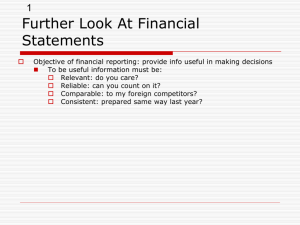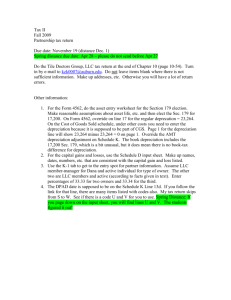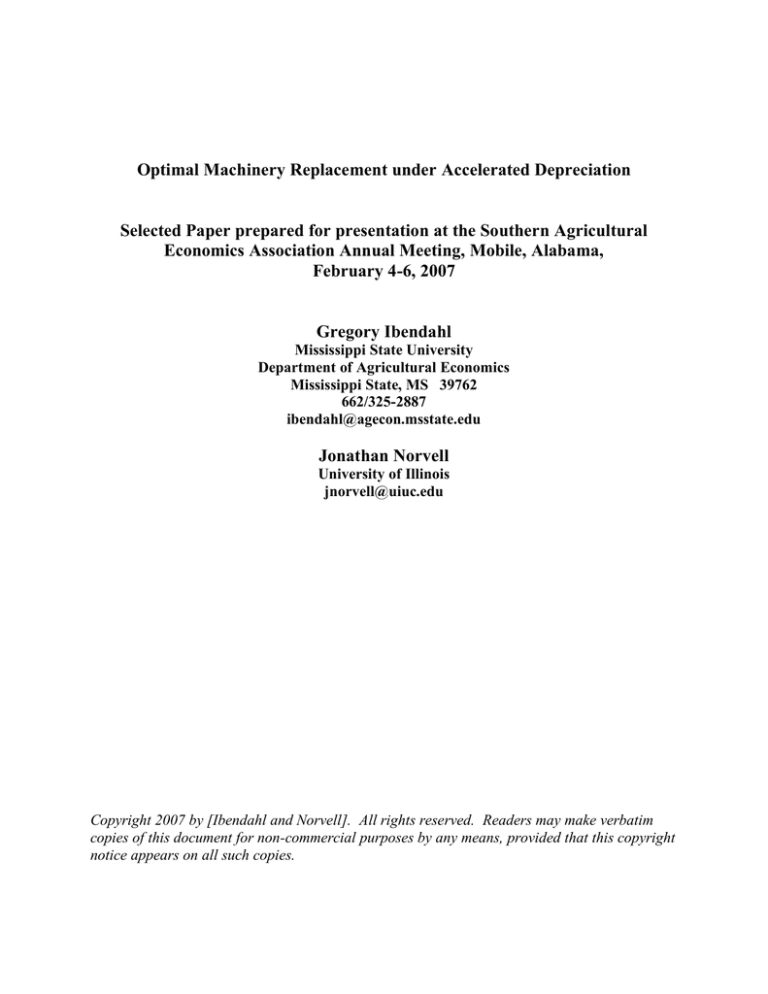
Optimal Machinery Replacement under Accelerated Depreciation
Selected Paper prepared for presentation at the Southern Agricultural
Economics Association Annual Meeting, Mobile, Alabama,
February 4-6, 2007
Gregory Ibendahl
Mississippi State University
Department of Agricultural Economics
Mississippi State, MS 39762
662/325-2887
ibendahl@agecon.msstate.edu
Jonathan Norvell
University of Illinois
jnorvell@uiuc.edu
Copyright 2007 by [Ibendahl and Norvell]. All rights reserved. Readers may make verbatim
copies of this document for non-commercial purposes by any means, provided that this copyright
notice appears on all such copies.
Optimal Machinery Replacement under Accelerated Depreciation
The last several years have seen tax law changes that provide accelerated depreciation for
farmers. The most recent tax law is the GO Zone established to help counties in states affected
by the 2005 hurricanes. The area in Mississippi offered GO Zone status actually covers twothirds of the state. Earlier, the Job Creation and Worker Assistance Act of 2002 offered
accelerated depreciation. While both these laws are temporary, they did offer farmers the
opportunity to take up to a 50 percent depreciation allowance for qualified new property. While
the Job Creation and Worker Assistance accelerated depreciation is basically over, the GO Zone
accelerated deprecation is still available through 2008.
While the preceding two tax laws are temporary and limited geographically, the 179
deduction is neither. The 179 deduction has been increased from $24,000 to $100,000 ($108,000
for 2006). There are still limits on what property qualifies and whether a farmer can actually use
this particular accelerated depreciation method.
Congress seems determined to allow businesses the opportunity to expense the majority
of the cost of a new durable asset in the first year of the asset’s life. For many farm assets, the
179 deduction allows a farmer to write-off the entire purchase price in one year. Laws such as
the GO Zone tax breaks allow additional depreciation beyond what is available under a 179
deduction. While the 50% acceleration allowance has been temporary, this is the second time in
five years that Congress has allowed additional accelerated depreciation
These laws seem to be designed to help stimulate the economy by encouraging farmers to
purchase more machinery and to replace machinery more often. Farmers do benefit because
2
lower taxes this year are probably better than lower taxes in future years (as long as marginal tax
rates are the same). Less clear, however, is whether farmers should actually replace machinery
more frequently. In other words, is the optimal lifespan of an asset reduced due to new
accelerated depreciation laws?
For most producers, machinery and equipment investments amount to a large percentage
of total assets. Given the small profit margins on many farms, replacing machinery at a less than
optimal age could significantly affect profitability. Finding the optimal asset age is also
important for planning and farm budgeting. This paper analyzes the new accelerated depreciation
laws to determine if the expected lifespan of farm machinery should be reduced. In addition, the
paper introduces stochastic elements into the model to determine if uncertainty about future costs
affects the replacement decision.
Most assets have an optimal lifespan. Financial theory has several ways to calculate the
expected optimal lifespan of an asset. These methods examine the purchase price, yearly
operating costs and profits, and final salvage value to determine the optimal asset life. These
methods all assume that assets become less productive over time or that their operating costs
increase each year. In general, as purchase price or yearly profit increases, the optimal lifespan
should also increase. By contrast, higher operating cost each year or a lower purchase price
should reduce the optimal lifespan.
Most capital purchases by businesses must be expensed over several years rather than
expensed all at once when purchased. A depreciation schedule recognizes the yearly expenses of
an asset being used up (Oltmans, Klinefelter, and Frey). Ordinary wear and tear, natural
deterioration from exposure to the elements, and technical obsolescence all contribute to the
3
yearly decline in asset value (FFSC). Therefore, depreciation is a procedure to match the decline
in asset value to the yearly expense taken.
Accelerated depreciation provides more profits in the beginning years which are
weighted more due to the time value of money. This has the effect of increasing the net present
value of profits. Therefore, accelerated depreciation should reduce the optimal lifespan of an
asset. The important question for producers is if this gain is actually enough to change the
optimal expected lifespan of farm machinery.
Previous work in this area examined tax law changes that were quite a bit different than
the most recent law changes. Much of the earlier work examined changes in investment credits.
In addition, the earlier work with optimal asset life used deterministic models.
These previous models that address the asset lifespan questions will be modified to
include current accelerated depreciation laws and will also make the variables for future costs
stochastic. The model will be applied to cost information about mid-size tractors to determine if
the anticipated replacement age changes. Sensitivity analysis will be used to test the robustness
of the results. Even though there is some variability with the inputs, farmers are really interested
in the lifespan for planning purposes.
Tax deprecation often does not reflect the actual decrease in asset value. Frequently, the
tax life of an asset is shorter than the asset’s actual life. In addition, many assets will have a
salvage value when sold whereas tax depreciation methods often take the book value of the asset
down to zero. Accumulated tax depreciation is the basis for an asset’s book value and the book
value may or may not reflect the asset’s true market value.
Background
4
According to the Farmer’s Tax Guide, most types of tangible property can be
depreciated. The main exception is land. Purchased breeding livestock can also be depreciated.
The main requirements for depreciation are: it must be owned property and used for business
purposes, and it must have a determinable useful life of more than one year.
Most property is depreciated under the Modified Accelerated Cost Recovery System
(MACRS) method. With MACRS, it is important to determine the asset’s placed-in-service date
and the recovery period. The depreciation scheduled can be easily calculated with this
information. For machinery, the recovery period is seven years. This paper assumes the half-year
convention when placed in service (Costin). This means machinery is assumed to be purchased
midyear. A seven year recovery period and a midyear start date results in a MACRS depreciation
schedule of 10.71% in year one, 19.13% in year two, 15.03% in year three, 12.25% in years four
through seven, and 6.13% in year six. As can be seen, the partial year convention actually adds
another year to the depreciation schedule.
The last several years have seen tax law changes that provide accelerated depreciation for
farmers. These changes allow farmers the opportunity to take more depreciation in the year the
asset is purchased. The most recent tax law is the Job Creation and Worker Assistance Act of
2002[4]. With this law, two methods of accelerated deduction have been increased. First, the 179
deduction has been changed from $24,000 to $100,000. In addition, the threshold for using the
179 deduction has increased from $200,000 to $400,000. Therefore, as long as a farmer does not
acquire more than $400,000 in section 179 eligible property, he or she can take up to the
$100,000 in 179 deduction expenses. Acquiring more than $400,000 in 179 eligible properties
reduces the amount of 179 expenses a farmer can take. There are still limits on what property
qualifies and whether a farmer can actually use this particular accelerated depreciation method.
5
The other major depreciation change is a special 50 percent depreciation allowance for
qualified new property placed in service after May 5, 2003 (Job Creation and Worker Assistance
Act of 2002). New property placed in service before May 5th can still use the 30 percent special
deprecation allowance that was enacted after 9/11. However, farmers cannot use both the 50
percent special depreciation allowance and the 30 percent allowance together. They can though
use both the special 50 percent allowance and the 179 deduction together. The only caveat is that
the 179 deduction is taken first and the 50 percent special allowance is applied to the remainder.
In general, the special 50 percent depreciation allowance has fewer restrictions on its use than
does the 179 deduction.
Model
Most assets have an optimal lifespan. Financial theory has several ways to calculate the
expected optimal lifespan of an asset. These methods examine the purchase price, yearly
operating costs and profits, and final salvage value to determine the optimal asset life. These
methods all assume that assets become less productive over time or that their operating costs
increase each year. In general, as purchase price or yearly profit increases, the optimal lifespan
should also increase. By contrast, higher operating cost each year or a lower purchase price
should reduce the optimal lifespan. Accelerated depreciation laws, by lowering profits in later
years and shifting the profits to earlier years, have the potential to reduce the optimal life of an
asset.
Previous work by both Perrin and Barry show how net present value rules can be used to
evaluate a replacement decision. Assets must be replaced when they wear out but often the
optimal replacement occurs earlier because either the productivity drops off or the repairs and
maintenance become increasing prohibitive. The model presented in Barry uses the asset cost,
6
yearly asset value, and yearly returns or costs to analyze the replacement decision. The model in
Barry is shown in equation 1.
(1)
V0 =
1
'S
1 ' (1 + i )
& S Rn
#
MS
( $)
+
' M0!
n
S
% n =1 (1 + i ) (1 + i )
"
This model does not specify taxes or how the tax shield of depreciation would affect the
decision. Modifying the model to include taxes and deprecation is given in equation 2.
& S . Rn ( (1 ' t ) + Dn ( t + M S ' (M S ' BS )( t
#
1
,
)
(
+
'
M
$
/
0!
'S
)
(1 + i )n
(1 + i )S
1 ' (1 + i ) % n =1 ,*
"
(2)
V0 =
V0 =
present value of perpetual annuity received every S years
S=
year of replacement
Rn =
return (cost) in year n
where
MS = asset value in year S
M0 = original asset value or purchase price
i=
discount rate
t=
ordinary income tax rate
Dn =
tax depreciation in year n
BS =
asset basis in year S
To find the optimal lifespan of an asset in either equation 1 or 2, the equation must be
solved for each possible year (i.e., S = 1 to maximum possible asset life). The year that provides
the greatest present value is the year the asset should be replaced.
There are three differences between equations 1 and 2. First, equation 2 allows for taxes
on the yearly return provided by the asset, Rn " (1 ! t ). This income tax term is independent of
7
depreciation and may have been implied in Equation 1. Next, Equation 2 provides for the tax
shield of depreciation, Dn ! t , in each year. Depreciation varies each year and in dependent upon
the depreciation method used. Finally, the term, (M S " BS )! t , represents the recovery of
depreciation if the asset is sold for more than the asset basis or book value. This gain is taxed as
ordinary income as long as the asset ending value is not above the original purchase price.
The basis, BS, in a given year can be defined as:
S
(3)
BS = M 0 " ! Dn .
n =1
Specifying the model in Equation 2 requires two assumptions. First, the asset does not
appreciate in value. If depreciation did occur, then capital gains would need to be added to the
model to account for the asset value increase. Appreciation was not specifically modeled in
Equation 2. The other assumption is that market value is always greater than the asset basis (i.e.,
MS > BS).
To make the model stochastic, a triangular distribution is used for the value of the tractor
in each year. A triangular distribution is used because data exists about the low, high, and midpoint values of used tractors but little other information is known. To make the model more
realistic, the yearly values are correlated. Again, not much information is known about
correlations between years so a 12 year correlation table was assumed. This correlation table has
a 0.9 correlation between the first year and second year, 0.8 correlation between the first year
and third year, and so on.
Data and Methods
To use the model in Equation 2 to evaluate the lifespan of a tractor, information is needed
about the price of a replacement tractor, repair and maintenance costs each year, the value of the
8
tractor at the end of each year, the interest rate, the marginal tax rate, and the tax depreciation
method. Information about new and used tractor prices comes from the Dealer Edition of the
Winter 2006 Official Guide. This guide lists the current value of new and used equipment for
each machine model. In this paper, a John Deere 7420 tractor is used to test the model. This
tractor is a 115 horse power tractor. Because John Deere changes models frequently, models
7410 and 7400 are used to complete the series and give 12 years of data. These older models are
quite similar to the 7420 tractor.
Four depreciation methods are tested. One is the standard seven-year tax depreciation.
Typically, assets are considered to be put into service at the midpoint of the year. Thus, normal
seven-year tax depreciation actually results in eight years of depreciation. The first and last years
are only one-half of normal. The second tax depreciation method uses the 50% special
depreciation allowance in the first year with the remaining value deducted following the typical
depreciation schedule. Because the only difference between normal and the 50% special
depreciation is an extra first year deduction, the tractor is still depreciated over eight years.
The third depreciation method tested is the 179 special depreciation allowance. The entire
cost of the tractor could be depreciated in year one if all the requirements are meant. Because the
limits have been raised on 179 deductions, more farmers can use this method than before. In this
paper, we assume the use of the 179 deduction takes the tractor’s value to zero in year one.
Depending upon the total assets purchased, the 179 deduction could be eliminated or reduced.
The last depreciation method is one where the tax depreciation matches the economic
depreciation. A test model is also included that ignores the tax benefits of depreciation.
Each set of prices from each year of data are tested to see if the tax depreciation method
does make a difference in the year the tractor should be sold. The data set is somewhat
9
constrained by the lack of good long-term information about repair and maintenance costs.
Results
Figure 1 shows the results for the five depreciation methods at a 7% interest rate. As the
figure shows, trading tractors in year 12 is optimal for the all the depreciation methods, even
when there are no tax benefits to depreciation. This figure is based on the expected value of the
yearly distribution. Figure 2 shows the results of how the stochastic tractor value affects the
results. The stochastic elements do not affect the year to trade
Conclusions
The results should be useful to anyone connected agriculture. Farmers can improve their
profitability by planning to replace their machinery at an optimal age. Lenders can manage
operating and other farmer loans better if they know how often assets are to be turned over.
Policy makers and Extension workers will have more knowledge about what kind of
recommendations to make to farmers. Finally, the results should show if accelerated depreciation
laws do help farm input suppliers sell more to farmers.
The accelerated depreciation is a benefit to farmer as it lowers their yearly cost (mainly
due to getting money earlier rather than later). However, the accelerated depreciation methods do
not affect the year the asset should be sold.
10
-80,000
1
2
3
4
5
6
7
8
9
10
-90,000
-100,000
-110,000
-120,000
.
-130,000
-140,000
-150,000
-160,000
Conventional
179 method
50% in yr 1 plus half regular
No depreciation
Dep = economic dep
Figure 1. Machinery Costs from Trading in Different Years
11
11
12
Confidence Intervals - Conventional Depreciation
-80000
-90000
-100000
-110000
-120000
-130000
-140000
-150000
-160000
1
2
3
4
5
6
7
Average
5th Percentile
75th Percentile
95th Percentile
Figure 2
12
8
9
10
11
25th Percentile
12
References
Barry, P. J., P. N. Ellinger, J. A. Hopkin, and C. B. Baker. Financial Management in
Agriculture. Danville, Illinois: Interstate Publishers, 2000.
Chisholm(a), A. H. “Effects of Tax Depreciation Policy and Investment Incentives on Optimal
Equipment Replacement Decisions.” Amer. J. Agr. Econ. 56(November 1974):776-783.
Chisholm(b), A. H. “Effects of Tax Depreciation Policy and Investment Incentives on Optimal
Equipment Replacement Decisions: Reply.” Amer. J. Agr. Econ. 58(May 1976):359360.
Costin, personal communication.
Farm Financial Standards Council (FFSC). Financial Guidelines for Agricultural Producers II.
December, 1997.
“Farmers Tax Guide.” IRS publication 225, available at http://www.irs.gov/pub/irspdf/p225.pdf. 2003.
Gustafson, C. R., P. J. Barry, and S. T. Sonka. “Utilizing Expectations to Measure Economic
Depreciation and Capital Gains of Farm Machinery.” Agribuiness Journal. 6(December
1990):489-503.
Job Creation and Worker Assistance Act of 2002. Public Law 107-147-Mar. 9, 2002. Available
at http://thomas.loc.gov/bss/d107/d107laws.html.
Kay, R. D. and E. Rister. “Effects of Tax Depreciation Policy and Investment Incentives on
Optimal Equipment Replacement Decisions: Comment.” Amer. J. Agr. Econ. 58(May
1976):355-358.
Oltmans, A.W., D. A. Klinefelter, and T. L. Frey. Agricultural Financial Reporting and
Analysis. Doane Agricultural Services Company, 1992.
Bentley, E., J. R. Waters, and C. R. Shumway. “Determining Optimal Replacement Age of Beef
Cows in the Presence of Stochastic Elements.” S. J. Agr. Econ. 8(December 1976):1318.
Perrin, R. K. “Asset Replacement Principles.” Amer. J. Agr. Econ. 54(February 1972):60-67.
Smith, V. H. “The Effects of Changes in the Tax Structure on Agricultural Asset Replacement.”
Southern Journal of Agricultural Economics. 22(July 1990):113-121.
13
Trapp, J. N. “Investment and Disinvestment Principles with Nonconstant Prices and Varying
Firm Size Applied to Beef-Breeding Herds.” Amer. J. Agr. Econ. 68(August 1986):691703.
14

